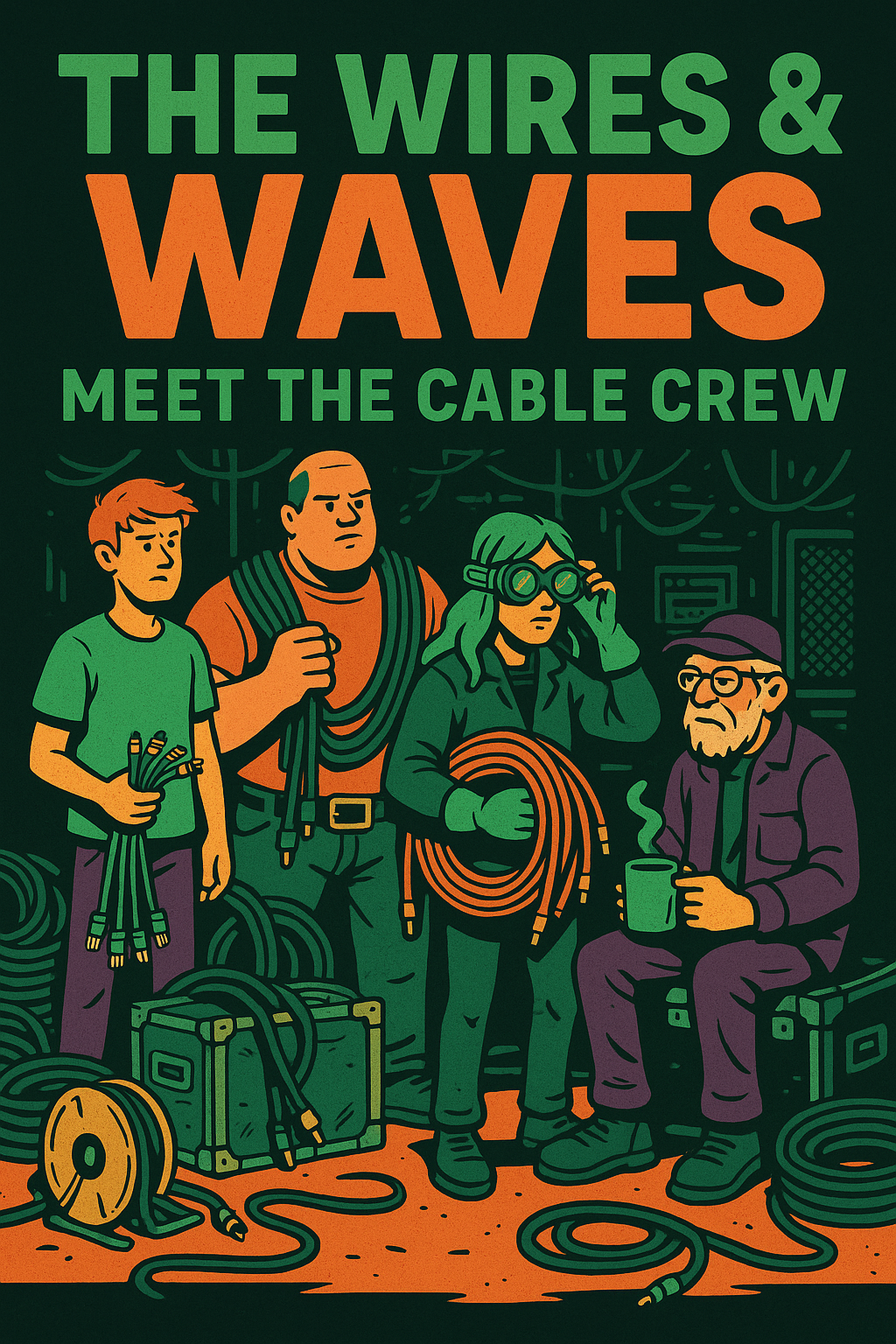
The Wires & Waves: Meet the Cable Crew That Keeps the Physical Layer Rocking
The Wires & Waves: Meet the Cable Crew That Keeps the Physical Layer Rocking
Think of this stop on the tour as load‑in day. The van’s parked behind the venue, doors open, and the cable crew is already moving like a swarm of caffeinated ants. Spools of Cat6a are rolling across the floor, fiber reels are stacked like drum cases, and the merch guy just tripped over an F‑type connector.
These aren’t just wires — they’re the lifelines that carry every riff, lyric, and light cue from one part of the venue to another. On the Network+ exam, this is the Physical Layer’s bread and butter: cables, connectors, speeds, distances, and safety ratings.
🎟 The Cable Crew – Music Role + Networking Role
Cat5e — The Intern
- Music Role: The junior roadie who’s been around forever. Knows enough to get by, but you wouldn’t put them on the main stage.
- Networking Role: Handles 1 Gbps up to 100 meters. Fine for older office runs or light‑duty backstage connections.
Cat6 — The Sprinter
- Music Role: Quick on their feet, great for short‑haul jobs, but burns out if you push too far.
- Networking Role: Can hit 10 Gbps but only for ~55 meters before dropping back to 1 Gbps for the rest of the run.
Cat6a — Big Mike (The Muscle)
- Music Role: The powerhouse who can carry two bass cabs at once without breaking a sweat.
- Networking Role: Supports 10 Gbps for the full 100 meters. This is your modern enterprise and main stage backbone cable.
| Category | Max Speed | Max Distance | Typical Gig Use |
|---|---|---|---|
| Cat5e | 1 Gbps | 100 m | Merch booth POS |
| Cat6 | 1–10 Gbps* | 55 m @ 10Gb | Small stage rigs |
| Cat6a | 10 Gbps | 100 m | Main stage backbone |
| Cat7 | 10+ Gbps | 100 m | Studio recording |
| Cat8 | 25–40 Gbps | 30 m | Data center tour ops |
💡 Tour Tip: Cat6a is the long‑haul headliner for 10 Gbps — Cat6 taps out early on long runs.
Fiber Optic — Laser Lisa
- Music Role: Runs the laser show from the lighting booth. Works in near silence but delivers jaw‑dropping results over massive distances.
-
Networking Role:
- Single‑mode (SMF): Laser light, insanely long runs (up to 40+ km). Yellow jacket.
- Multi‑mode (MMF): LED light, shorter but cheaper (up to 500 m). Orange or aqua jacket.
Coaxial — Old Man RG
- Music Role: The retired guitar tech who still shows up for certain gigs. Knows stuff nobody else remembers.
-
Networking Role:
- RG‑6: Modern cable TV/internet.
- RG‑59: Short CCTV runs.
Shielded vs. Unshielded Twisted Pair — The Armor Crew
- Music Role: The gaffer who wraps every cable in extra protection before it hits the stage.
-
Networking Role:
- STP (Shielded Twisted Pair): Foil/braided shield to block interference — great for noisy environments.
- UTP (Unshielded Twisted Pair): Cheaper, lighter — most common in offices.
Connector Types — The Plug Crew
- Copper: RJ45 (Ethernet), RJ11 (phone), GG45 (high‑speed Ethernet upgrade)
- Fiber: LC, SC, ST, MTRJ
- Coax: F‑type, BNC
Punchdown Blocks & Keystone Jacks — The Backstage Patch Panel
- Music Role: The rack of labeled outlets behind the stage where everything gets plugged in before the show.
- Networking Role: Punchdown blocks (like 110 blocks) secure cable runs in structured cabling. Keystone jacks snap into wall plates and patch panels.
Plenum vs. PVC — Venue Safety
- Plenum‑rated: Fire‑resistant, low‑smoke — required in air ducts & ceiling spaces.
- PVC: Cheaper, fine for open spaces — not for air‑handling spaces.
Crossover vs. Straight‑Through — Who Plugs Into Who
- Straight‑through: Different devices (PC → switch, mixer → amp).
- Crossover: Same devices (PC → PC, switch → switch).
Fiber Cleaning — The Stage Dusting
- Music Role: The stagehand with a microfiber cloth making sure every mic stand is spotless before the headliner walks out.
- Networking Role: Dirty fiber connectors cause signal loss. Use proper cleaning tools to keep them clear.
⚡ Mini‑Scenario — Soundcheck Test
The tour’s lighting rig needs a 10 Gbps uplink to the control booth 80 meters away. Which cable do you send Big Mike to run?
Answer: Cat6a — full 10 Gbps at 100 meters.
🎯 Why This Matters
Without the cable crew, the show is dead before it starts. Same in networking — the wrong cable means dropped signals, failed tests, and a very grumpy tour manager.
> Last note sent by Ben Tankersley